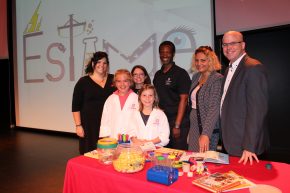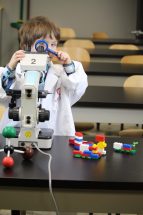Ce n’est pas une observation nouvelle : les filles sont sous-représentées dans les domaines d’études liés aux sciences, aux technologies, à l’ingénierie et aux mathématiques (STIM). Dans les entreprises, c’est la même chose : les femmes n’occupent que 22% des postes en technologies chez Apple, 20% chez Intel, 18% chez Google, 17% chez Microsoft et 16% chez Facebook.
C’est pour renverser cette tendance que Julie Bergevin, enseignante au département d’Éducation à l’enfance du Collège Laflèche, a imaginé une façon créative de faire découvrir les sciences aux jeunes enfants.

L’automne dernier, l’équipe de l’École branchée avait rencontré lors d’un congrès cette enseignante passionnée et porteuse d’un projet novateur. Aujourd’hui, grâce à la collaboration de nombreux partenaires et au financement du programme NovaScience (ministère de l’Économie, des Sciences et de l’Innovation), mais avant tout grâce à la détermination de Julie, le projet a pris officiellement son envol.
Faire une différence dès le plus jeune âge
Convaincue que plusieurs éléments influencent la participation, la progression et la réussite des filles et des garçons dans les STIM et que le service de garde fait partie intégrante de la solution, Julie a élaboré le projet ESTIME.

ESTIME pour Éveil aux Sciences, aux Technologies, à l’Ingénierie et aux Mathématiques dès l’Enfance. ESTIME aussi parce que ce projet vise à augmenter l’estime de soi des enfants par les STIM et à augmenter le sentiment de compétence des futures éducatrices à l’enfance face aux différents domaines des sciences.
L’objectif ultime de Julie : augmenter l’intérêt des filles envers les programmes d’études des sciences et des technologies en les mettant en contact avec des outils technologiques et des modèles féminins et déconstruire certains préjugés par rapport aux emplois liés au domaine scientifique.
« On le sait : l’enfant apprend par le jeu. Tout en s’amusant, il va pouvoir apprendre que le domaine des sciences est stimulant, varié et qu’il n’est pas accessible seulement aux garçons. »
Une collaboration inter-programme
Grâce à une collaboration avec le département des sciences de la nature, les étudiantes d’Éducation à l’enfance du Collège Laflèche auront accès aux différents laboratoires (chimie, physique, biologie) ainsi qu’au LAB 321 muni d’imprimantes 3D et d’une découpe laser. Elles pourront ainsi vivre des expériences et s’outiller en science et technologie pour ensuite se servir des notions apprises dans l’élaboration d’activités éducatives.
Une collaboration des plus inspirantes entre deux domaines d’études qui n’ont pas l’habitude de travailler ensemble.
« Les sciences, ce n’est pas juste pour les scientifiques, mais bien pour tout le monde qui s’y intéresse »
Intégrer les sciences et les technologies dans la formation d’Éducation à l’enfance

Dans un premier temps, le projet ESTIME vise à outiller les éducatrices à l’enfance afin qu’elles soient en mesure d’éveiller les enfants aux STIM. Cette démarche sera conçue et enseignée au sein même du programme d’Éducation à l’enfance, et ce tout au long des trois années du programme. Dans un deuxième temps, les étudiantes seront encouragées à mettre en application les notions apprises et les différentes stratégies auprès des enfants pendant leur stage et au cours de leur carrière.
De plus, un site Internet sera conçu pour les différents établissements d’enseignement qui offrent le programme Éducation à l’enfance. On y retrouvera des outils, des capsules et des références pour guider les éducateurs à l’enfance.
« L’enfant qui passe plusieurs heures par semaine en compagnie de son éducatrice qui comprend l’importance des STIM pourra bénéficier d’un environnement d’apprentissage plus stimulant où il sera permis de réaliser des projets liés aux sciences, tout en s’amusant, sans aucun stress de performance académique »




 Recevez l'Info #DevProf et l'Hebdo pour ne rien manquer des nouveautés de l'École branchée!
Recevez l'Info #DevProf et l'Hebdo pour ne rien manquer des nouveautés de l'École branchée!




